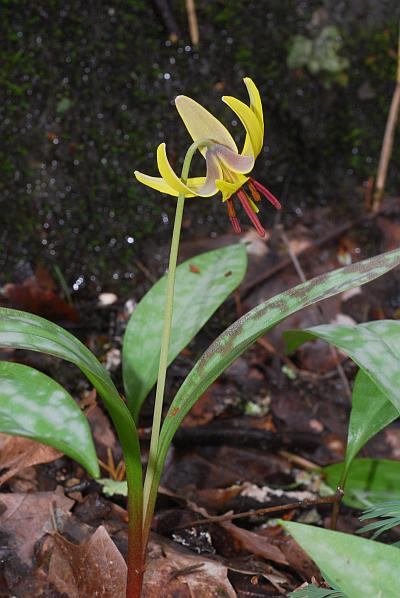Erythronium americanum Ker Gawl.
Yellow Adder's Tongue

Native
CC = 8
CW = 5
MOC = 21
© SRTurner
Erythronium americanum Ker Gawl.Yellow Adder's Tongue | |
 |
Native CC = 8 CW = 5 MOC = 21 |
© SRTurner |
|
Family - Liliaceae Habit - Perennial forb with deep bulblike corms. Stems - Aerial scapes to 20 cm, ascending to erect, unbranched, glabrous. Stolons produced, typically 2-5 per corm. Leaves - Basal, petiolate, typically two per fertile plant, (one leaf on sterile plants). Blades 1.5-7.0 cm wide, lanceolate to narrowly ovate or elliptic, entire, flat, glabrous, not glaucous, usually somewhat mottled with brown.
Inflorescence - Single flower terminating scape, typically only one per plant. Flower nodding. Flowers - Perianth of 6 tepals, glabrous, strongly reflexed, yellow, sometimes tinged with orange, brown, or green, the petals lacking appendages or with a basal pair of poorly developed, broadly triangular to rounded appendages, if present these not wrapped around the filament of the opposing stamen. Stamens 6, fused to base of tepals. Filaments to 1.7cm long, 1.5mm broad, yellow, glabrous. Anthers 1.3 cm long, red or purple. Stigma 1, 3-lobed, 0.5-1.5 mm long, the lobes stout, spreading. Ovary 1.3 cm long, 3-angled, 3-locular, green, glabrous, superior. Placentation axile.
Fruits - Obovate capsules, the tips broadly rounded or straight across, sometimes with a minute apiculum at the very tip, positioned off the ground by the ascending or gradually spreading aerial stem, usually not erect. Flowering - March - May. Habitat - Mesic forests, ravines, along streams, slopes. Origin - Native to U.S. Lookalikes - Erythronium rostratum. Other info. - In Missouri this striking species is found mainly in the southeastern (eastern Ozark) region. Elsewhere its distribution is mostly to our northeast, to the Atlantic coast and into Canada. The yellow flowers are easy to spot against the leaf litter of the woods. This species can be found in colonies of sterile, one-leaved plants along with a few fertile, two-leaved plants. The closely related E. rostratum appears similar, but that species has triangular appendages at the base of the petals which wrap around the opposing stamens. This distinction is far easier to observe in fresh plants than pressed, dried material, so determinations should be made carefully in the field.
Photographs taken at Silver Mines Recreation Area, Madison County, MO, 4-8-2019 (SRTurner). |